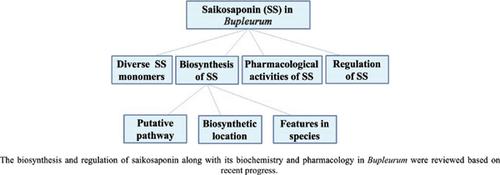Current Pharmaceutical Biotechnology ( IF 2.2 ) Pub Date : 2021-02-28 , DOI: 10.2174/1389201021999200918101248 Chun Sui 1 , Wen-Jing Han 1 , Chu-Ran Zhu 1 , Jian-He Wei 1

|
Background: Chaihu is a popular traditional Chinese medicine that has been used for centuries. It is traditionally used to treat cold fever and liver-related diseases. Saikosaponins (SSs) are one of the main active components of chaihu, in addition to essential oils, flavonoids, and polysaccharides. Considerable effort is needed to reveal the biosynthesis and regulation of SSs on the basis of current progress.
Objective: The aim of this study is to provide a reference for further studies and arouse attention by summarizing the recent achievements of SS biosynthesis.
Methods: All the data compiled and presented here were obtained from various online resources, such as PubMed Scopus and Baidu Scholar in Chinese, up to October 2019.
Results: A few genes of the enzymes of SSs participating in the biosynthesis of SSs were isolated. Among these genes, only the P450 gene was verified to catalyze the SS skeleton β-amyrin synthase. Several UDP-glycosyltransferase genes were predicted to be involved in the biosynthesis of SSs. SSs could be largely biosynthesized in the phloem and then transported from the protoplasm, which is the biosynthetic site, to the vacuoles to avoid self-poisoning. As for the other secondary metabolites, the biosynthesis of SSs was strongly affected by environmental factors and the different species belonging to the genus of Bupleurum. Transcriptional regulation was studied at the molecular level.
Conclusion: Profound discoveries in SSs may elucidate the mechanism of diverse the monomer formation of SSs and provide a reference for maintaining the stability of SS content in Radix Bupleuri.
中文翻译:

在柴胡皂苷生物合成研究进展柴胡
背景:柴胡是一种流行的中药,已有数百年历史。传统上,它用于治疗感冒和肝脏相关疾病。除精油,类黄酮和多糖外,Saikosaponins(SSs)是柴胡的主要活性成分之一。在当前进展的基础上,需要付出相当大的努力来揭示SS的生物合成和调控。
目的:本研究旨在总结SS生物合成的最新成果,为进一步的研究提供参考和引起关注。
方法:截止到2019年10月,此处汇总和展示的所有数据均来自各种在线资源,例如PubMed Scopus和中文百度(Baidu Scholar)。
结果:分离到一些参与SSs生物合成的SSs酶基因。在这些基因中,只有P450基因被证实可催化SS骨架β-淀粉酶合成酶。几个UDP-糖基转移酶基因被预测与SS的生物合成有关。SS可以在韧皮部中大量生物合成,然后从原生质(即生物合成位点)转运至液泡,以避免自身中毒。至于其他次生代谢产物,SS的生物合成受到环境因素和柴胡属不同物种的强烈影响。在分子水平上研究了转录调控。
结论:SS中的深层发现可能阐明了SS中不同单体形成的机制,并为维持柴胡中SS含量的稳定性提供了参考。











































 京公网安备 11010802027423号
京公网安备 11010802027423号